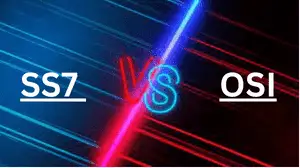In the world of telecommunication, the seamless transmission of data and communication between network devices is crucial. This is made possible by various protocols that govern the flow of information. Two significant protocols that have revolutionized the telecommunications industry are Signaling System 7 (SS7) and the Open Systems Interconnection (OSI) model.
While both protocols serve the purpose of enabling efficient communication, they differ in their underlying architecture, functionality, and areas of application. In this article, we will delve into a comparative analysis of SS7 vs OSI, exploring their features, strengths, weaknesses, and their respective contributions to the telecommunications landscape.
Contents
Signaling System 7 (SS7)
Signaling System 7 (SS7) is a telephony signaling protocol used for controlling and managing voice and data traffic on public switched telephone networks (PSTN). It operates at the network layer (Layer 3) of the OSI model and provides services such as call setup, routing, and termination. SS7 uses a packet-switched network to establish and maintain connections between network elements, ensuring efficient call signaling and robust network management.
SS7’s architecture consists of three primary components: the service switching point (SSP), the signal transfer point (STP), and the service control point (SCP). The SSP initiates and terminates calls, the STP routes signaling messages between SSPs, and the SCP provides databases and services for call control and management.
One of the key strengths of SS7 is its ability to handle advanced telephony services such as caller ID, call forwarding, and short messaging service (SMS). It has played a significant role in the development of various telecommunication technologies like mobile networks and voice over IP (VoIP).
Open Systems Interconnection (OSI) Model
The Open Systems Interconnection (OSI) model is a conceptual framework that standardizes network communication protocols. It defines seven layers, each responsible for a specific function, facilitating interoperability between different systems. The seven layers of the OSI model are the physical layer, data link layer, network layer, transport layer, session layer, presentation layer, and application layer.
Unlike SS7, which is a specific protocol, the OSI model provides a reference framework for the development of protocols and services. It serves as a blueprint for designing and implementing network architectures, ensuring compatibility and seamless communication across diverse network environments.
The OSI model’s layer-by-layer approach enables modular design and simplifies troubleshooting, as each layer performs distinct functions. For example, the network layer handles routing and addressing, while the transport layer ensures reliable delivery of data between end systems.
SS7 vs OSI: A Comparative Analysis
- Scope of Application: SS7 is primarily used for signaling and call control within telephony networks, ensuring reliable and efficient call setup and routing. On the other hand, the OSI model provides a framework for designing and implementing network protocols across various industries and technologies, including telecommunication, data transmission, and computer networks.
- Protocol vs. Framework: SS7 is a specific protocol that operates at the network layer, while the OSI model is a conceptual framework that defines seven layers. SS7 can be seen as an implementation of a subset of the OSI model’s functionalities.
- Granularity: SS7 operates at a lower layer (Layer 3) of the OSI model, focusing on signaling and call control. The OSI model, with its seven layers, provides a more granular approach, allowing for a detailed specification of network functions and services at each layer.
- Interoperability: The OSI model promotes interoperability by defining standardized protocols at each layer. It enables different systems to communicate seamlessly, irrespective of the underlying hardware and software. SS7, although not directly based on the OSI model, can benefit from its principles of interoperability when integrated into larger network architectures.
- Evolution and Adaptability: The OSI model has stood the test of time and continues to serve as a reference for network design and development. It allows for flexibility and adaptability, with the ability to accommodate new protocols and technologies. SS7, while widely used in the telecommunications industry, has faced challenges in adapting to modern communication technologies like the internet and mobile networks.
- Architecture: SS7 follows a distributed architecture with various functional entities. It operates at the Network layer of the OSI model. On the other side, OSI model adopts a layered architecture, where each layer performs specific functions to facilitate communication.
Conclusion
SS7 and the OSI model are two significant players in the realm of telecommunication protocols. While SS7 focuses on signaling and call control within telephony networks, the OSI model provides a conceptual framework for designing and implementing network protocols across diverse industries.
SS7’s strength lies in its ability to handle advanced telephony services, contributing to the development of various telecommunication technologies. On the other hand, the OSI model’s layer-by-layer approach promotes interoperability and enables seamless communication across different systems.
While both SS7 and the OSI model have their strengths and weaknesses, they have played instrumental roles in shaping the telecommunications landscape. As technology advances and new communication paradigms emerge, these protocols will continue to evolve, adapt, and contribute to the seamless transmission of data and communication in the ever-connected world.
